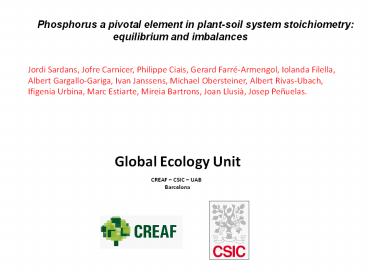Phosphorus a pivotal element in plant-soil system stoichiometry: - PowerPoint PPT Presentation
1 / 16
Title:
Phosphorus a pivotal element in plant-soil system stoichiometry:
Description:
Phosphorus a pivotal element in plant-soil system stoichiometry: equilibrium . and imbalances. Global . Ecology. Unit. CREAF CSIC UAB. Barcelona. Jordi ... – PowerPoint PPT presentation
Number of Views:120
Avg rating:3.0/5.0
Title: Phosphorus a pivotal element in plant-soil system stoichiometry:
1
Phosphorus a pivotal element in plant-soil system
stoichiometry
equilibrium and imbalances
Jordi Sardans, Jofre Carnicer, Philippe Ciais,
Gerard Farré-Armengol, Iolanda Filella, Albert
Gargallo-Gariga, Ivan Janssens, Michael
Obersteiner, Albert Rivas-Ubach, Ifigenia Urbina,
Marc Estiarte, Mireia Bartrons, Joan Llusià,
Josep Peñuelas.
2
Key role of phosphorus
Crucial element for all living organisms (DNA,
ATP, ...) and ecosystems.
Pivotal for the functioning of the Earths
biogeochemical cycles and climate.
Controls agricultural production and its impacts
on society.
3
The fact that I am working in aquatic
ecosystems takes my attetion on the role of
phosphorus in limiting and regulates the
biosphere production capacity, this highlights
the secondary role of P-poor structures as wood
in terrestrial ecosystems or the cement and
metals in human civilization.
Ramon Margalef
4
At ecosystem-biocenosis level the role of P is
not independent of the
other nutrients, such as N
Phosphorus and ecological stoichiometry studies
Terrestrial ecosystems
Aquatic ecosystems
Growth Rate Hypothesis (GR)
Andersen Hessen 1991 Elser et al. 1996
Sterner Elser 2002
Main constrains
- Greater complexity and specialization
- of organs (leaves, stems, roots,..)
-N and P can be allocated in great amounts to
more functions than growth
4
NP
P
3
-Other elements, and water economy
2
NP
P
1
5
Taking into account more than growth (coupling
metabolomics to ecological stoichiometry studies)
Stoichiometry Metabolomics
Elemental Stoichiometry
Drought
S Spring Season
Metabolome
N/P Sugars Amino acids
K and KP ratio
Osmolites (sugars)
Rivas-Ubach , Sardans, Peñuelas et al. (2012) PNAS
Peñuelas Sardans (2008, Nature)
6
(No Transcript)
7
More P accumulation with size in slow- than in
fast-growing forestal species
Sardans Peñuelas 2014 GEB
8
Different elements and different plant functions
A new work hypothesis
Different elements participate asymmetrically in
different plant functions and structures
C (structure,..)
N (growth, light capture, metabolism
functioning,..)
P (growth, energy transfer,)
HOMEOSTASIS Consequence of the optimum
adaptation to maximize species fitness in
determined abiotic and biotic circumstances,
(Genotype)
K (water economy, internal transport,)
Mg (light capture,)
Biogeochemical niche
FLEXIBILITY but also of short-term capacity to
respond under certain limits to life-time
environmental competition shifts (Genotype, and
Phenotype flexibility)
Each species, as a singular evolutive
product, should have an optimum elemental
composition as consequence of optimum function
Peñuelas et al. (2010 Global Change Biology)
9
Strong phylogenetic signal
More than the 50 of the variance of foliar
elemental composition stoichiometry of the
main set of European forestal species is
explained by species
Sardans et al. GEB 2014, Submitted
10
Species explains more than a 50 of total
variance in foliar elemental composition in
European forest
Sardans et al- (2014)
11
Global P-cycle is being altered by human activity
Peñuelas et al. (2013) Nature Communications
12
What it is happening with P stoichiometry
imbalances at global scale?
Bibliography provides several partial evidences
that increases in NP could be occuring in
several ecosystems at global scale
Peñuelas, Poulter, Sardans et al.(Nature
Communications 2013)
13
(No Transcript)
14
Global climate and C-balance models related to
global change should include the changes in
nutrients balances and stoichiometry
Peñuelas et al. (2013) Nature Communications
Phosphorus and N/P ratio could be gaining role in
global capacity to C fixation and consequently
in the global climatic control
But there are a lack of studies investigating the
overall impacts on global ecosystem (elemental
composition shifts, changes in nutrient cycles,
in diversity, in trophic web structure and so on
altogether) by P stoichiomtry unbalances
15
A chalenge to
reach Synergy gives us an opportunity to advance
Space (along environmental
gradients)
MANY
FAST
HIGH
Energy and matter transfer
1.How and what species can adapt?
Nutrient cycling
Diversity
2. Because N and P supply can detrmine the
capacity to change ADN composition (Acquisti et
al. 2009) and genetic expression (Jeyasingh et
al. 2009).
Trophic levels
Growth strategy
N, P, K, Mg, Ca, S, Fe,availability and
stoichiometry
Carbon storage capacity
Can be determined by
Trade offs and synergies
3. We expect tht the esults of This project can
be useful to improve the earth
system Model. 4. How can be a furhter scenario
of the Relationships of humans and their
activities With phosphovels at different levels
(ffod Security geeconomy,..) and scenarios
Ecosystem evolution (Plant soil
system)
LOW
FEW
SLOW
Environmental shifts (atmospheric N deposition,
climate, pollution, species invasion, soil use,)
Time
16
Thanks for your attention

